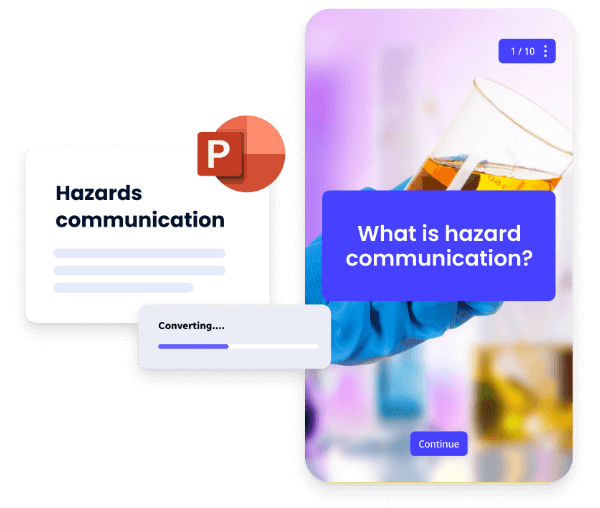What is staff training? Benefits, examples, & best practices

The recent years have introduced major changes in the workplace. With the increasing popularity of remote and hybrid setups, more companies have developed flexible management styles — ultimately transforming the way we work. It’s important to keep up with changing times, and the same goes for your staff training.
In this article, you’ll learn how to foster a culture of learning in your workplace. Read on to discover the definition, benefits, examples, and best practices of staff training.
What is staff training?
Staff training refers to initiatives that help employees acquire the necessary skills and knowledge for their roles. It’s a worthwhile investment made by companies to make sure their employees have the capabilities to perform their jobs efficiently and effectively.

Why is staff training important?
A 2023 survey conducted by PwC, a multinational professional services firm, found that 60% of employees who received specialized training feel better equipped to anticipate work changes in the next five years. On the other hand, the 20% who don’t receive training are not as confident in facing challenges at work.

There are plenty of benefits to staff training. From increasing productivity and profit to building accountability, it’s a win-win case for both employer and employee. Here's why you need to train your staff:
- Boosts productivity
Training boosts employee morale and productivity as it makes them feel taken care of. This sense of satisfaction paves the way for thinking outside the box and performing efficiently. Employees will also make fewer mistakes as they're trained to deliver consistent quality output.
- Increases profit
A perfect combo to boost productivity is increased profit. When employees can perform their tasks efficiently, this helps the company since reduced errors mean fewer resources being used. Staff training welcomes more profit for the company in the long run.
- Promotes transparency
Fostering trust in the workplace is crucial to a company’s success. Hosting staff development training gives employees a closer look into the company’s strategies, goals, and decision-making affairs. This, in turn, will make them more invested in the company, so they’ll genuinely strive for it to succeed.
- Builds accountability
Staff training and development initiatives minimize the need for supervision and build accountability instead. With newly acquired skills, your employees will feel more confident in their roles and will only need you to double-check their output once finished. So, what this means for you is now you’ve got more time on your hands! Use this to focus on larger projects that you didn’t have the chance to prioritize before.
- Attracts fresh talent
Investing in staff training shows the job market that your company cares for its employees in the long term. In fact, LinkedIn’s Workplace Learning Report reveals that 94% of employees would stay longer at a company if it offered them opportunities for career advancement.
Indeed, job seekers have done their research. They’re interested in top training companies that invest in their employees’ growth. By training staff, you’ll be at the top of their list.
Examples of staff training
While there are plenty of staff training programs out there, we’ve rounded up three examples commonly implemented by companies:
Leadership
Leadership training equips your employees with a better understanding of their roles and opens the doors for them to become skilled leaders in the future. From working on their decision-making to communication and team-building skills, leadership training is a great way to refresh employees’ mentality about their roles.

Compliance
Compliance training is crucial to enforce as it makes employees aware of the rules, laws, and regulations they’re expected to follow. There’s a growing tendency to take policies for granted especially if they’ve been around for a long time. Compliance training saves the company from potential fines or lawsuits and minimizes risk for everyone in the long run.

Time management
Let’s face it, no matter how long you’ve been in the industry, time management is a skill that’s tough to master. That’s why it’s important to teach your staff how to spend their working hours wisely. Time management training reduces stress and helps boost productivity as employees can confidently get things done faster each day.

How to make staff training effective and engaging
For your workplace training methods to be effective and engaging, you’ve got to be strategic about your implementation. Since this isn’t limited to one approach, customize your employee training according to what’s relevant to their needs. This can either be done formally through classroom-based instructions and lectures, or informally through group discussions and role-playing. The possibilities are endless!
To help you get started, we’ve collected some of the best practices for staff training below.
1. Design a training plan
It’s crucial that your employee training is organized and aligned with the company’s overall goals. Laying out the details in the open for each session gives your staff clarity and a greater sense of purpose on what they’re ultimately working toward.

Devising a training plan that maps out your goals reduces slip-ups on your part since you already have an outline of how your meetings will play out. Break down learning outcomes to make them easy and manageable for everyone to follow. Overall, taking a structured and clear approach to your training plan is the recipe for success.
2. Include real-world examples
The key to effective staff training is giving employees realistic scenarios they can connect with. It softens any resistance or disinterest on their part and boosts their engagement instead. Start your training with a catchy narrative or case study to draw them in, and tweak any details as necessary. Giving employees authentic scenarios they can relate to secures knowledge retention.
3. Incorporate digital software
If you’re struggling to find ways to make your performance management strategies more engaging, you don’t have to look far ahead. Incorporating digital software into your staff training lifts the burden as it’s got plenty of features you can customize for your training needs.
Top mobile learning platforms like SC Training offer microlearning, which can take your training to the next level. Deliver highly targeted lessons that can be finished in under five minutes anytime, anywhere. And if you don’t know where to start, don’t worry as it has over 1,000 courses you can customize for free!

4. Adopt different learning styles
We all process information differently. As the manager, you know your employees best and what’s relevant to their needs. Catering to different learning styles promotes an inclusive workplace and shows that individual growth is a top priority.

Here are three common learning styles and instructional suggestions to take note of:
Auditory learning
Some learners retain information best through sound. Instead of reading through huge chunks of text, they prefer to listen to live or recorded lectures.
For this type of learning, you should require active participation. Give employees a space to share their thoughts by initiating discussions, or include audio and video clips in your staff training sessions.
Kinesthetic learning
A multi-sensory learning approach suits kinesthetic learners best. Here, mind and body come together as one. While these learners can process information through reading, it must be paired with touch or body movement for maximum retention.
Rather than confine them to lecture meetings, offer practical courses where employees can interact with models and objects hands-on to test their skills.
Visual learning
Visual learners absorb information by imagining the big picture. This learning style calls for a “show, don’t tell” approach. Instead of flooding them with words, offer learners something to imagine.
Make sure to include pictures, charts, or graphs in your training. If you already have some teaching materials stored away, workforce management tools allow you to convert existing physical documents into vibrant PowerPoint presentations for free. No coding is needed!

5. Gather feedback
At the end of your staff training, make sure to collect feedback to evaluate performance. This allows you to assess which lessons were the most effective and identify possible areas for improvement.

You can shake things up by incorporating gamification into your feedback through interactive quizzes and polls to assess employee knowledge retention. While this software may be costly to find, look no further as SC Training offers this and more — all for free! Forever for as long as you need it.

Overall, gathering feedback helps track employee performance and serves as a valuable resource for mapping out future training.
Take your staff training to the next level with the best training platform. Sign up for SC Training at no cost.
Author
Bea Maureen Cayone
Bea Maureen Cayone is a content writer for SC Training (formerly EdApp), an eLearning platform that delivers advanced solutions for companies to seamlessly train their teams. Beyond the workplace, she enjoys catching up on her never-ending reading list, playing the piano, and spending time with her dogs.
